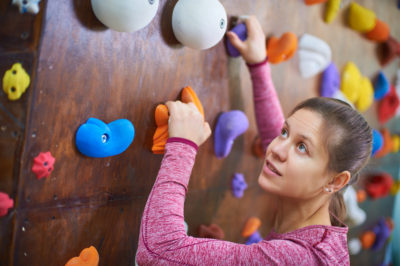For the absolute beginner, asking about bouldering handholds and footholds is a great question. Let’s dive in.
So what are those things on bouldering walls called? The grips on bouldering walls are called handholds and footholds. Some of the holds on gym walls replicate natural formations found outside on real boulders, while other holds are unique to gym environments.
Handholds and footholds come in a huge variety of shapes and sizes, and different techniques and approaches apply to the different holds.
What Are Bouldering Handholds and Footholds?
Bouldering handholds and footholds, also called climbing handholds and footholds, are those plastic-like grips attached to the climbing walls on bouldering gyms. Bouldering holds come in many different shapes and sizes. The difficulty of a climb can in part be due to the size and type of holds on the problem.
One important feature that defines a hold is its positivity. Positivity refers to how easy the hold is to grab. The more positive a hold is, the more it sticks out from the wall and the easier it is to use. A hold with high positivity will stick well out from the wall and will have a handle or prominent edge. A positive hold allows you to pull yourself towards it. Jugs, described below, are an example of a positive hold.
A very negative hold, on the other hand, offers no chance of pulling yourself towards it because there is no edge or lip to grab. The smaller the edge on a hold, the harder it is to grab and the more negative the hold it is. A negative hold is used by taking advantage of friction. A sloper, described below, is an example of a negative hold.
As well as positivity, the surface texture on a boulder handhold or foothold will also have an effect on how easy it is to use. A hold that has a roughly textured surface will be easier to grab and hang on to than one with a smooth surface. Negative holds frequently has a rough surface, to offset their lack of an edge to grab.
Generally speaking, a more difficult problem, or bouldering route, will have smaller, more negative, and smoother footholds and handholds. Beginners will appreciate route problems with larger, highly positive, and textured holds. To see an introductory article on bouldering problems, click here.
What Are the Most Common Types of Bouldering Gym Handholds?
The size and shape of a handhold will determine how it is gripped, where and on which types of problems it is located, and how people use it when climbing.
- Jugs: these have a handle or very prominent lip to grab. A jug is the easiest hold to use since one’s hand just wraps around it, like hanging on to the rungs of a ladder. Larger jugs will even have enough room for both hands. Smaller jugs, where only one hand will fit in the hold, are called mini-jugs. Since jugs are so easy to use, they are often found on beginner problems. They are also used on more difficult routes as mid-problem rest stops.
- Slopers: imagine a half watermelon glued to the wall – round side facing out. Since there are no edges to grab, and no handle to hold, slopers are considered the most negative type of hold. Friction of the open hand against the surface allows the climber to use the sloper to pull themselves up. These holds usually have a rough texture to make it easier to get some resistance. Slopers are considered a more advanced type of hold, and are rare on beginner problems.
- Crimpers: these are a small edge, a thin strip of surface, on which to place your fingerpads to pull yourself up. Crimps are too small to fit more than the tips of the fingers, and are considered one of the most difficult handholds to use. The crimp grip is a method used on these types of holds. Overusing crimp grips can lead to chronic tendon injuries, so be very careful to only use the crimp grip on crimpers.
- Underclings: looking like a half mushroom stuck on a tree trunk, you push up against the underside of the hold’s surface – it you are lucky it has a lip – and pull it toward you. With underclings it is important to have your weight on solid footwork, as the upward force comes from your legs.
- Pinches: these are what they sound like. You grab them like you would pinch your nose, with thumb on one side and fingers on the other. Your squeeze on the hold gives friction to pull yourself up or guide your next move. These vary in size, some are large enough for a full hand grip, while others are very small for fingertips only. It takes a lot of hand strength to use these, so they are found on more advanced bouldering problems.
- Pockets: like donuts, these have a hole for fingers to slip in. Unlike jug holds, which have the opening on the edge so it can be grabbed, pockets have the hole inset within the hold itself. The size of the hole can be big enough for several fingers. A pocket that is only large enough for one finger is called a mono. These holds are very hard on the hand’s tendons, and must be used very carefully, with good technique and solid footwork.
In general, beginner problems will have easier, more positive, and larger handholds. Advanced problems will tend to have more of the smaller, negative holds. Be wary of gym routes that rely on small holds to make the problem more difficult, instead of using more difficult moves. These types of problems set you up for chronic tendon injury.
What Are the Most Common Types of Bouldering Gym Footholds?
- Edges: an edge is a ledge on which your place your foot. Depending on the shape and thickness of the ledge, you would place toe, heel, or inner or outer edge of the foot on the edge. Good form requires keeping the foot horizontal, rather than sloping down from the edge.
- Smears: like slopers for handholds, smears are negative holds with no edges. Smears are used by relying on friction between the foot and the hold to get leverage. The trick to successfully using a smear is to have as much contact as possible between the foot and the surface. Often this is best achieved with a sloping foot position.
Note that in most gyms, unless it is otherwise posted, any hold can be used as handhold or foothold as needed. For example, crimps are often intended to be used as footholds on problems.
How Do I Know Which Holds to Start with in the Gym?
A bouldering gym route is usually coded with a specific colour: either the holds themselves will all be the same colour, or there will be tape of a specific colour on the wall next to each hold to indicate the route. The starting holds will usually be marked with tape in the shape of an arrow. If only one handhold is marked, and it has double arrows, this means that you start off with both hands on the same hold. Occasionally, a route may have a one-handed start.
You must start the route – that is, get off the floor and onto the wall – with your hands on the marked starting holds, but your feet can go on whichever footholds work for you. Only after you are solid and steady in the starting position do you move on to the next holds in the problem.
Related Questions
How do gym holds differ from natural rock holds? Most gym holds allow the thumb to be used, so you are often using a pinch grip, but thumb engagement is rare when bouldering on natural rock. Gym holds tend to be larger and easier to use, and allow more body positioning and leverage, than outdoor surfaces would. The surface of gym holds will be kinder to your hands than bare rock would be. For these reasons, progressing from indoor to outdoor bouldering requires some adaptation.
Are there any rules about bouldering starts? Strict bouldering rules only apply in competitions, but generally, you are considered to have started a problem once you are no longer in contact with the ground. Hands should be on a marked starting hold. If the problem has a one-handed start, the other hand should be in the air or touching only the wall; no hands should be touching a hold that is not marked as a starting hold. For casual gym bouldering, you try to start according to the route setter’s intentions but there are no hard-and-fast rules.

